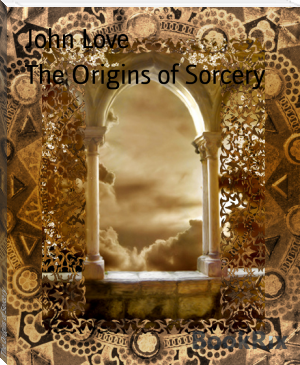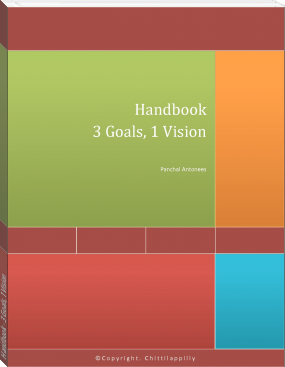Practical Witchery! - John Stormm (best novels to read for beginners TXT) 📗

- Author: John Stormm
Book online «Practical Witchery! - John Stormm (best novels to read for beginners TXT) 📗». Author John Stormm
Chapter 8
1 Moreover Azazyel taught men to (A) make swords, knives, shields, breastplates, the fabrication of mirrors, and the workmanship of bracelets and ornaments,(B) the use of paint, the beautifying of the eyebrows, the use of stones of every valuable and select kind, and all sorts of dyes, so that the world became altered.(C)
(A) Artificing, and metallurgy. (B) The craft of placing “glamours”.
2 Impiety increased; fornication multiplied; and they transgressed and corrupted all their ways.
(C) The effect of “glamours”, is to affect to draw the eye, and make someone or something to appear as more to be desired. In this verse, we can see that it had its desired effect.
3 Amazarak taught all the sorcerers, and dividers of roots:
4 Armers taught the solution of sorcery;(D)
(D) Pharmacology. Druggists
5 Barkayal taught the observers of the stars, (E)
(E) Observers of the effects of specific stellar alignments. Astrologers
6 Akibeel taught signs;(F)
(F) Omens and indicators of influences unseen being at work.
7 Tamiel taught astronomy;(G)
(G)The study of the physical bodies in their movements in space.
8 And Asaradel taught the motion of the moon,(H)
(H) The effects of Lunar cycles upon nature.
9 And men, being destroyed, cried out; and their voice reached to heaven.
The crafts having their designed effects, were being used to gain power over others, as it has ever since.
*End of Excerpt*
Indeed, there are a great many other, and similar writings confirming that this or that god or goddess, came down and brought the people this, or that specific knowledge. Many make these out as religious mythos, and then the people worshipped them, and built fine temples for the priests , and passed the plate around, collecting much money, and fabulous wealth. Amen! But such will never be MY approach as a scholar of such antiquities as I have been trained in.
Much as I am taking the time here, to write down the knowledge and wisdom, that I have been taught, in the language of my times, wherein I might have some chance of being heard and understood, for the posterity of my people (YOU). I read these ancient diatribes, with the same respect of the wishes of the ancient authors, and instead of proclaiming them as mysteries, for the powerful, elite few: They wrote them down for anyone who could read them, or even as Jesus often said: He who hath ears to hear it; let them hear! So these “mysteries” from an advanced race of people from the stars, are going to need to be elaborated a bit upon, for our imposed religiously and culturally enforced ignorance. First, we’ll go back to the proper definition of a spell, just in case you’ve been jumping chapters:
SPELL: A set period of time, where an influence, or influences are brought to bear, to accomplish a desired goal.
We can sharpen a stone or a piece of steel and call it a knife. But when we want a worthy knife, that will not fail to cut, every time and everything we want to cut: We need to consider what influences that we are capable of bringing to bear, to accomplish the crafting of such a knife. Such knowledge is available from a myriad of sources. Like the old “fastest gun in the West” icon, in order to survive and thrive, we need to have our extra, added edge, to give us the advantage over the less knowledgeable, and less skilled practitioners of the “fast draw.” In the metallurgical craft that Azazyel taught: He gave men a knowledge of how to work the metals, what metals to work, into specific ways, such as swords and knives. He even taught them how they even might be used, to defend against such other implements of war, by crafting such things as breastplates and shields.
You can collect your ore, to smelt into bar stock, and hammer out a blade and sharpen it on a stone. Depending upon the hardness of the metal, it will hold an edge, up to a certain point of usage, before it requires more sharpening. Whether we are speaking of the sword, the swordsman, witch or wizard: To serve to our safest, and our fullest capacity, we must always be at our sharpest. If we make our metal too hard, it becomes nearly as brittle as glass. It will truly hold as fine an edge as broken glass, but will not withstand dropping on a hard surface, or being struck by another piece of metal. We have to think ahead, when we are crafting something for a particular use. We don’t want to arm our soldiers and fighting men, with swords that cut, and last for only one stroke, and leaving them defenseless on the field of battle, immediately there after. There are a multitude of benefits, to having your men of arms surviving long enough to be veterans, and not simply dead heroes.
For such as we are discussing here, we can learn our best techniques, from the craftsmen noted for making the best swords. In this case: the ancient Japanese. They came about this problem often, as they were also constantly in a state of war, and with samurai dueling about all over the place. Knowledge is POWER, and we as wise, must learn to take our knowledge from every source that we can gather it from. I will speak only briefly on how they managed this great craft, because this is not a book on blade making. It is a book on how and why certain things work better than others, and determining how to bring all of these things to bear in your own crafts, and become all the wiser and effective for this.
The ancient Japanese sword smiths learned, that if they folded their steel over, many, many times, and then sharpened and tempered their blades just so: That they could produce a blade that held a very serious edge in battle, and yet be flexible and resilient enough, to take many hard blows without shattering like glass! The WHY and HOW of this comes from the layers of steel. When heated, the inner layers stayed just a bit “softer” than the more greatly heated and carbonized exterior layers of steel. This gave the blades a bit more flex, in the core of the weapon, and the hardness of the exterior steel, to hold a fine edge. The Japs love a great “fast draw” artist as much as any lovers of a good western, (they call it “Iaido”) and well know the value of cultivating an edge, over all of their prospective competition. Hence, they’ve had some of the finest, and best documented swordsmen on the face of the Earth.
Miyamoto Musashi’s, Book of Five Rings, is an excellent treatise on what he had noted, that worked best for him, to not just survive sixty duels, but to WIN them. Itself and Sun Tsu’s, Art of War, are excellent examples of how knowledge being POWER, going beyond the mystical realms and into practical usage. But you must also keep the holistic approach in all things, because that simply knowing a good martial strategy, will not make one able to succeed when their weapons shatter. And having a fine weapon, will not help a fool ,who has never acquired any skill with them. For that we have an old Irish saying: “Never give a sword to a man who can’t dance.”
A fellow must obviously know how to get his big feet out of the way of his own blade, and how to move in such a coordinated way, as to make the best cut possible. If you’ve been paying attention, you can already see that there are a great many influences that we can bring to bear, to make a better knife or sword and even a better swordsman, to wield such an implement successfully. This is our proper spellcraft, and it ensures that our efforts do not go unrewarded. We do not wave sticks and chant to be respected by superstitious sheep. We work our craft to its utmost, because as being formidably wise, we ARE forces in ourselves, to be respected of everyone that we encounter.
There are a great many forces and influences beyond the mere hardening of iron implements, that we can bring to bear, to accomplish the crafting of an item, that will not fail us in attaining specific goals. The soft core, and hardened shell of steel, is only a fraction of what is available to use, and sometimes just a good cut, is not ALL that we need for an item to succeed in its prescribed purpose or destiny. A great many things go into the crafting, or Artificing of a “named item”. I will show a few items, we have crafted at our own forge, and a bit about what was added to the crafting, to make them more able, to be applied to their specific tasks.
My first item to show here is an athame called, “Huntress”. Many Wiccans use athemes in rituals and ceremonial magick. They are very individualized to the use of each witch. And since they are “ceremonial,” and not really used for cutting anything, but symbols of power and authority: Most of these are never sharpened, but are dull edged. From my Grandma’s usage of such, in Danaan witchery, if the blade was not useful as a cutting tool, then its “power” or ability to serve, was limited, or questionable. It had to be a serviceable tool for her crafting. She sometimes used her athame to cut herbs, vines and cords, to do her specific kind of witchery. So naturally, as her Danaan protégé, I crafted my athame with a dual cutting edge. This one is also of a design, that anyone or anything, with any serious intelligence, will NOT want to be pierced with. It grants its wielder a measure of real personal authority in a given situation.
It was also known among the nearly immortal Sidhe, and the fae; that they had a weakness, or a vulnerability, to being pierced by cold iron. It was said, that they were driven out of their predominance of ancient Ireland at sword point. In making a worthy tool, for a witch who may encounter such influences in her craft and rituals, I needed every edge that I could put into this weapon to give her more clout, with whatever she met. This doesn’t mean, that she’s expected to attack anything she sees. It only means that she CAN, only if she NEEDS to, and that it WILL have some effect. When a fae, or an animal smiles, it reveals its fangs. It is not a sign of mirth, but significant of showing their place, on the proverbial food chain, or their “authority“. Human teeth are as blunt as any grass eater’s, hence my athame had its own place on the “food chain,” as the superior “fang” of a sort.
In its ceremonial capacity as a variation on the wand, it could be kept sheathed in its “unicorn horn” shaped casing, and still be a proper focusing item of one’s personal energies. The “Lunar Triple Goddess” emblem inlaid within its scabbard, was crafted of lunar elements and signified the relationship of its user, who was a practicing Lunar witch. But when the blade was bared, it carried the promise that this would not be the ineffective bite of a grass eater at all. The bearer was due some respect as any good Sidhe





Comments (0)